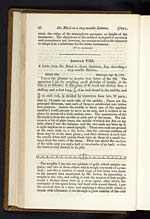Joseph Black (1728-1799)
Letter from Dr Black to James Smithson Esq. describing a very sensible balance
52
Dr. Black on a very sensible Balance.
[JULY,
tures, the value of the atmospheric pressure, or height of the
barometer. The objections to the method in regard to accuracy
and convenience are, however, too serious to induce the observer
to adopt it as a substitute for the latter instrument.
(To be continued.)
_______________________
ARTICLE VIII.
A Letter from Dr. Black to James Smithson, Esq. describing a
very sensible Balance.
DEAR SIR,
Edinburgh, Sept. 18, 1790.
I HAD the pleasure to receive your letter of the 9th. The
apparatus I use for weighing small globules of metals, or the
like, is as follows: A thin piece of fir wood not thicker than a
shilling, and a foot long, 3/10 of an inch broad in the middle, and
1½/10 at each end, is divided by transverse lines into 20 parts;
that is, 10 parts on each side of the middle. These are the
principal divisions, and each of them is subdivided into halves
and quarters. Across the middle is fixed one of the smallest
needles I could procure to serve as an axis, and it is fixed in its
place by means of a little sealing wax. The numeration of the
divisions is from the middle to each end of the beam. The ful-
crum is a bit of plate brass, the middle of which lies flat on my
table when I use the balance, and the two ends are bent up to
a right angle so as to stand upright. These two ends are ground
at the same time on a flat hone, that the extreme surfaces of
them may be in the same plane; and their distance is such that
the needle when laid across them rests on them at a small dis-
tance from the sides of the beam. They rise above the surface
of the table only one and a half or two-tenths of an inch, so that
the beam is very limited in its play.
[NLS note: a graphic appears here – see image of page]
The weights I use are one globule of gold, which weighs one
grain; and two or three others which weigh one-tenth of a grain
each; and also a number of small rings of fine brass wire made
in the manner first mentioned by Mr. Lewis, by appending a
weight to the wire, and coiling it with the tension of that weight
round a thicker brass wire in a close spiral, after which the
extremity of the spiral being tied hard with waxed thread, I put
the covered wire in a vice, and applying a sharp knife which is
struck with a hammer, I cut though a great number of the coils


